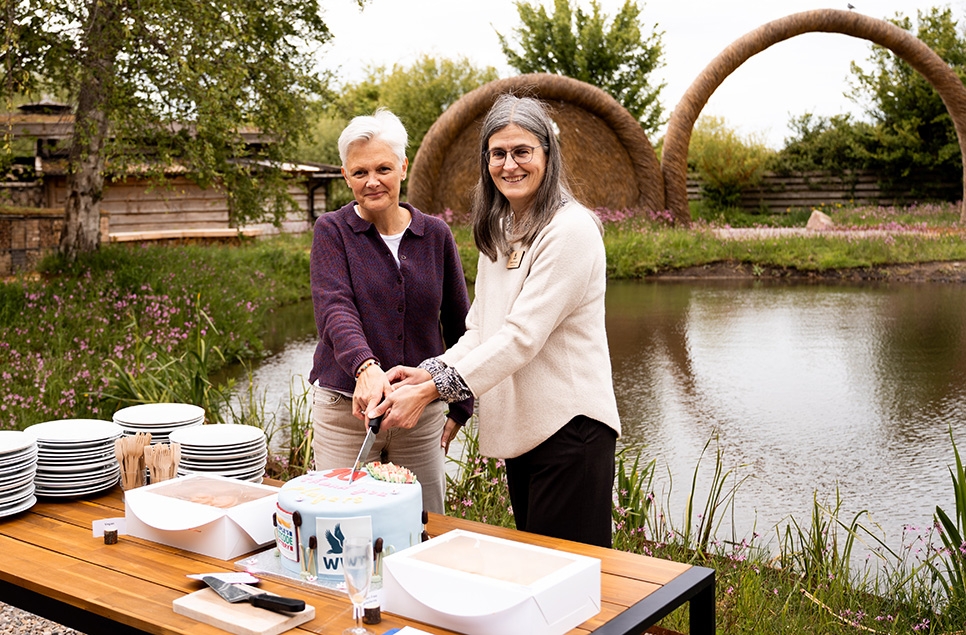New study shows allowing the sea back in could help UK meet climate goals
Findings demonstrate restored coastal saltmarsh, created through re-connecting the land to the sea, stores more carbon, faster, than forests

Leading up to the UN Conference on Climate Change (COP 26), newly published research from Manchester Metropolitan University has found that one restored coastal saltmarsh in the UK stores as much carbon over four years as just over one million new trees grown for ten years.
The study’s authors found that the 250 hectare (c. 467 football pitches) restored saltmarsh at WWT Steart Marshes in Somerset:
- Buried organic carbon at a rate of over 19 tonnes per hectare per year, resulting in a total of over 18,000 tonnes of carbon (67,000 tonnes of carbon dioxide) being buried at the site over the four year study period
- This is equivalent to
- taking 32,900 UK cars off the road for one year
- the greenhouse gas emissions from powering 77,930 UK homes for one year - The rate at which carbon was stored was 18 times higher than the rate currently being used to estimate the carbon storage potential of saltmarsh in the UK
The study measures one saltmarsh, but the potential to scale up this habitat’s exceptional carbon storage potential is significant. A 2019 government commissioned report identified 22,000 hectares of land around the UK coast that could be restored to saltmarsh. If this happened, applying today’s results, at the top end, over 425,000 tonnes of carbon could be trapped every year instead of being released back into the atmosphere – a significant step towards helping reach net zero targets by 2050.
Tim McGrath, Head of Project Development for Nature-Based Solutions at the Wildfowl and Wetland Trust (WWT) said:
“Before this study we didn’t fully appreciate just how well certain saltmarshes with the right conditions like Steart Marshes can perform in terms of storing carbon. These exceptional findings could indicate that the carbon storage potential of restoring saltmarsh around the UK coast has been underestimated. Today’s study sends a clear message to policy makers that creating saltmarsh shows huge promise as a significant tool in the fight against climate change.”
Rachel Dunk, principal lecturer at Manchester Metropolitan University and co-author of the study said:
“Our study is one of the first to measure, at scale, an evolving saltmarsh in the first years after it’s been reconnected to the sea through breaching sea walls. Remarkably, not only did the newly restored saltmarsh at Steart store huge amounts of carbon, but the speed at which it was trapped was far higher than the current estimated rates for UK saltmarshes. This is due largely to the position of Steart on the Severn Estuary which has high sedimentation levels and a large tidal range.”
Coastal wetlands like Steart Marshes are cost-effective and land efficient because they store more carbon per hectare than other habitats such as forests. Despite this, coastal saltmarsh is not fully factored into any government climate change policy and is not included in the government’s Net Zero Strategy: Build Back Greener, announced earlier this week in the lead up to COP 26. And while there are currently carbon offsetting codes for peatland and woodland, no such policy exists for saltmarsh.
Tim McGrath commented:
“We are asking the government to ensure that ‘blue carbon’ habitats, including saltmarsh, are included in their climate change plans. We are joining forces with other environmental organisations to call for this on 4 November at COP 26* in Glasgow. Trees and peat can take us so far, but ‘blue carbon’ eco-systems, such as saltmarshes, can take us further and it’s time government seized this opportunity.”
“We’ve lost over 90% of saltmarsh in this country, it’s time to reconnect the sea in a managed way to previously drained land and reap the benefits.”
According to Conservation International, mangrove’s offsetting potential could be worth £9-£15 per tonne of carbon dioxide. Mangrove is another example of a blue carbon habitat. Using this estimate, the amount of carbon dioxide that has stored at WWT Steart Marshes’ could be worth £604,908 - £1,008,180 over four years. A consortium of charities, scientists and financial experts, including WWT has started work on calculating just how much the UK’s saltmarsh’s carbon storage ‘service’ could be worth.
WWT is continuing to work with Manchester Met to use the study to help identify and map other areas with qualities similar to Steart Marshes where highly effective ‘super’ saltmarsh carbon sinks can be created around the UK coast.
WWT is asking the public to get behind its call for more wetlands like Steart Marshes to be created in the UK to help combat today’s climate, nature and wellbeing crises. People can pledge their support for the creation of 100,000 hectares of healthy wetlands by visiting wwt.org.uk/WetlandsCan.
Carbon accumulates in saltmarshes as sediment carried in by the tide is deposited and buries decomposing carbon-storing saltmarsh plants (stored through photosynthesis). This ‘organic’ carbon is then buried deeper and deeper as each sea tide brings in layer upon layer of wet mud. More carbon is trapped for longer than in woodlands and other habitats where decomposing plants above ground release carbon back into the atmosphere.



